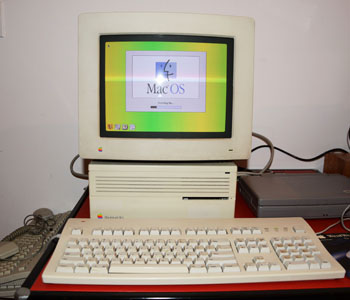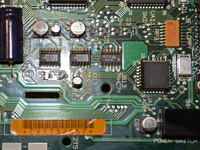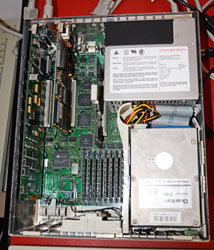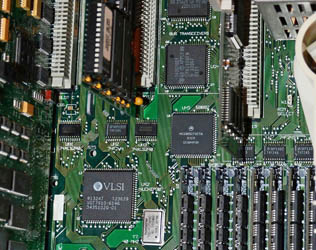Apple Macintosh IIciDesktop ComputerReleased on September 20th, 1989, the IIci is part of the Macintosh II family of computers from Apple, essentially being an upgraded version of the IIcx. Some of the main features include integrated video hardware, a 25 MHz 68030 CPU (up from 16 MHz on the IIcx), a maximum of 128 MB of RAM, and a built-in SCSI hard drive. The IIci was discontinued on February 10th, 1993, after about 3 years and 5 months of production. There were two IIcis in the Crasno collection—both were sold in late 2019 along with nearly all of my vintage computing hardware, since my focus has shifted to analog electronics, especially older and more serviceable devices. I repaired them in July 2015, the details of which are explained below. Features
RepairsThere is a very common problem of vintage Macs that had affected both of my IIcis: the surface-mount electrolytic capacitors had leaked their corrosive electrolyte onto the motherboard. If left too long, this liquid can dissolve the board's traces and solder joints, causing connections to be broken. Luckily, the leaking on my machines was not too severe, and thus they were restored to working order after capacitor replacement. PRAM batteries were also replaced in both (1/2 AA 3.6V lithium cells), which is a very straightforward process unless the batteries have leaked their corrosive insides—thankfully they hadn't. Below is a picture of some of the original capacitors on one of the boards, after some cleaning had already been done. Note the presence of liquid, and that some traces have discolored sections. Note that even if a trace is discolored, it may still be fine, since it does take a fair while for a trace to dissolve all the way through. Nonetheless, once the original capacitors have been removed, the board should be cleaned thoroughly to remove any corrosive liquid remaining. I used cotton swabs soaked in isopropyl alcohol; today I would also follow this up with an Electrosolve wash. In some cases as well, liquid had formed a paste in between pins of some of the chips, which was carefully scraped out with an X-acto knife. Desoldering the original surface-mount electrolytics is relatively difficult, since most of the lead-length lies underneath the capacitor, unable to be touched with a soldering iron. I consider this a terrible package design that, like most surface-mount packages, was created for the sake of automated manufacturing at the expense of human workability and thus repairability. At the time, I didn't know about a very useful trick, so I just used a fine-tipped iron, tinning the iron's tip with a blob and pressing this to the exposed area of a pad, which worked decently except on the most corroded pads. In my case, only one pad in total was lifted (after doing both motherboards), requiring a small jumper wire to make the connection. If I had known in 2015, I would have used this trick shown by Mr. Carlson. Basically, the capacitor body is twisted, breaking off its leads right above the pads. It may seem clumsy and risky, but in my experience, it is the safest way to get rid of these troublesome parts. It works even on surface-mount capacitors that have not leaked. After breaking off the capacitor body, the insulating spacer simply lifts off the board, and then the pads can be cleaned off with wick. Various options exist as to the types of capacitors that are able to replace the surface-mount aluminum electrolytics originally used. While traditional electrolytic capacitors remain the cheapest, they are not recommended, since they have the shortest lifespan, and of course, since they can potentially leak all over again. Some recommend surface-mount tantalum capacitors, but these, like the electrolytics, have barely-protruding leads that are difficult to solder, and are polarized. The best type, in my opinion, is the MLCC—Multi-Layer Ceramic Capacitor. These are non-polarized, have very large and easily accessible solder pads, and no liquid electrolyte. The only drawback is that they are relatively expensive, but the cost is still not very significant, at a maximum of a few CAD per capacitor. Interestingly, IIci motherboards utilize some MLCCs from the factory, but only for lower capacitance values. Both of my IIcis have the same revision of motherboard (820-0242-A), which utilizes the following surface-mount electrolytic caps:
The above quantities are for a single motherboard. These can be replaced by the following parts (with their Mouser part numbers listed), which are what I used:
Since they were also leaking, I replaced the electrolytic caps on the two cache cards, each of which uses 2x 22µF capacitors, with one card using 35V and the other using 25V units. The following part was used to replace all four capacitors:
Below are two images of the replacement capacitors installed. The one on the right shows the small jumper wire that was added due to a lifted pad. At the same time as replacing the surface-mount electrolytic caps, the axial-leaded units were also replaced. This was unnecessary, since the removed units tested fine, and of course, I have pieces of equipment more than 20 years older than the IIcis with good electrolytics. So, unless they show physical signs of deterioration, I wouldn't bother replacing them. Anyway, if you have a Mac IIci or other vintage Mac, I would highly recommend checking yours to see if anything has started leaking (mostly the capacitors, but the lithium battery should also be checked). If so, a short-term fix would be to clean up the liquid using cotton swabs soaked in isopropyl alcohol. Eventually though, they must be replaced—after all, the capacitors go increasingly out-of-spec as they leak. Of course, if you are lacking soldering and general electronics experience, I wouldn't recommend trying it yourself. There are people who can perform a recap for you for a reasonable cost. I used to advertise my services here, but I no longer perform these repairs because of how irritating and risky they are. Another thing I recommend checking are the pins of the 68030 processor, making sure none are touching each other. These pins are very closely spaced and delicate, and can easily be shorted together (or close to it) by accident. One of my IIcis had two such shorts. HardwareBelow is an image taken with the top cover off, which can be removed simply by lifting the two clips at the back (unless one screw is holding it, which is possible, but I have never seen it). Where the IIcx has a 16 MHz 68030 CPU & 68882 FPU, the IIci brings this up to 25 MHz, with the same chip types, although a different CPU package—the IIcx has a PGA 68030, where the IIci has a smaller QFP package. We can see that aside from the capacitors, most component-level repair would be seriously difficult, if not practically impossible with these large surface-mount chips. At least they're not BGAs, I guess! Originally, the IIci would have come with either a 40 or 80 MB hard drive. Mine both had larger drives; one has a 210 MB Quantum Prodrive 210S, while the other has a 2.1 GB Seagate Barracuda ST32550N. As for RAM, the IIci originally came with 1 MB or 4 MB, but with remarkable upgradability. At maximum, the IIci can use a whopping 128MB of RAM. Consider for a moment: it is common for a modern computer to come with 1 to 4 GB of RAM, but to be upgradeable to 128 GB would be unbelievable! This goes to show that either some computer specs have reached practical limits, or that manufacturers now limit upgradeability to increase disposability—I think both are true. In any case, depending on which machine I was interested in using, I'd install all of my eight RAM sticks into it, rather than keeping four in each machine, since they do have to be installed in groups of four. Physically, the case is nearly identical to that of its predecessor, the IIcx. It is also very similar to that of the later Quadra 700, so much so that relplacing a IIci's motherboard with that of a Quadra 700 was an upgrade promoted by Apple. It is easy and common to dismiss older computer hardware as being incapable of useful function in today's world. Although such machines are not the most practical, if the machine is working properly, it virtually cannot be incapable of useful function, considering it was useful enough to be sold for plenty of money to begin with. On the last point, the IIci's original list price in 1989 was $6,269 USD (or $8,798, depending who you ask). This would explain the high upgradeability; Apple should once again consider this, given that they are selling some of the least upgradeable and least repairable machines on the market, yet also among the most expensive, especially when comparing specs. That is not to say, of course, that vintage machines like these are equivalent in function to modern machines; they are not. In the case of the IIci, having been introduced in 1989, it was produced before many people used the internet. Even when significantly upgraded, it is really impractical for internet use, although it is technically possible to view some webpages using the machine. However, certain things like word processing can be done much the same as on modern computers, and it's often easier to run older Mac software on real hardware than to mess with virtual machines, plus you get to appreciate the beauty of the CRT monitor and the whirring of the SCSI hard drive. Not to mention that it has a floppy drive capable of reading Mac-formatted 400k and 800k double-density disks, which is something most modern USB floppy drives cannot do. Links
|
| If you notice any errors or have additional information that you would like to add, please contact me! |





